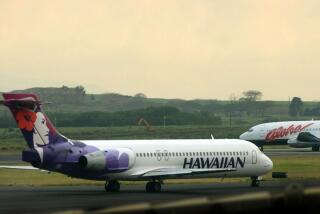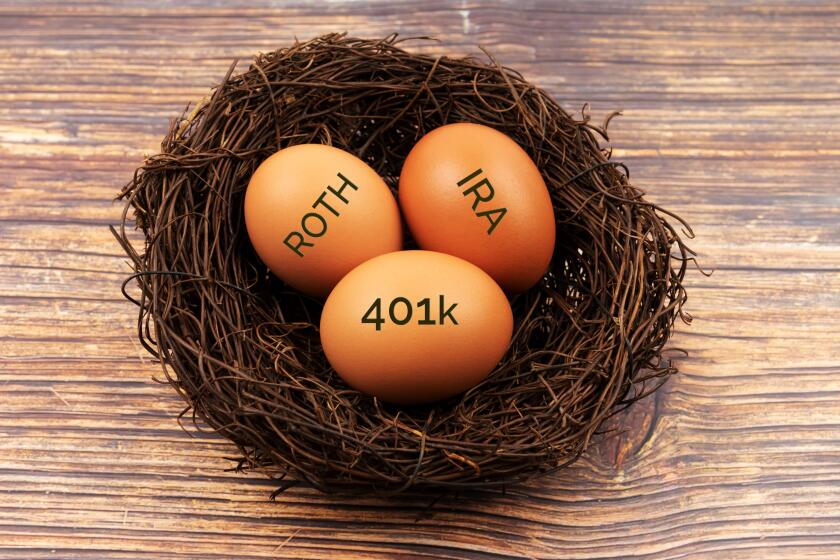United Agrees to Buy Pan Am Pacific Routes : $750-Million Deal, Which Must Be Approved by U.S. Is Seen as Strengthening both Companies
- Share via
NEW YORK — In a move that observers said would strengthen both airlines, United Airlines plans to buy Pan American World Airways’ Pacific division for $750 million in cash, the two companies announced Monday.
The plan, which would turn about a quarter of Pan Am’s system over to United, would give the big Chicago-based carrier the routes into the Far East that it has long sought.
The sale requires both regulatory and presidential approval. If completed, it would remove Pan Am from a large part of the world to which the airline had been an air travel pioneer in the 1930s.
Pan Am has lost $762 million since 1980, including $206.8 million last year. The company said that the sale would substantially strengthen its balance sheet by helping it to reduce its long-term debts and lease obligations, which total about $1.326 billion. In addition, Pan Am, which had more than $400 million in cash at the end of 1984, was forced to spend most of that during a long strike last month by its ground personnel.
Reassures Employees
United, on the other hand, had profits of $282 million last year and $142 million in 1983.
At a press conference in Washington, Pan Am Chairman C. Edward Acker sought to reassure both the carrier’s 26,000 employees and its shareholders that the sale was not an act of desperation by the beleaguered airline.
“Pan Am will be at least as large an airline in 1986, measured by . . . any popular measurement you like, as it was in 1984,” he said. “This transaction is being done because, in the opinion of management and the boards of both companies, it is a business transaction that makes sense and is manageable in the opinion of both parties.”
Richard J. Ferris, president and chief executive of UAL Inc., United’s parent company, said at the same press conference that “most mergers have occurred out of duress. This merger is being brought about willingly on the part of both parties. We think that tremendous expanded opportunities will accrue to all employees. We plan to carry this off in a manner that will not be a disadvantage to any employee, either of United or Pan Am.”
Includes 18 Planes
In its announcement, United said that it would absorb about 2,700 Pan Am employees. It said it plans to take over the Pan Am Pacific operation as a going enterprise: Besides routes to Japan, China, Australia, New Zealand, Hong Kong, Singapore, Taiwan, Korea, Thailand and the Philippines, it would acquire 18 jetliners, parts, property, facilities and all assets and rights necessary to carry on the Pan Am business.
Pan Am will continue to operate between Hawaii and the U.S. mainland. The two airlines said also that they planned to consolidate their frequent flier programs so that no customers would lose any mileage they had accrued.
United currently has one daily flight each to Hong Kong and Tokyo from Seattle and Portland. By purchasing Pan Am’s Far Eastern operations, it would acquire that airline’s good will with customers and travel agents in that area of the world.
Pan Am, which was founded in 1927 with two airplanes and 24 employees, has a long history of flying to the Far East. It was the first airline to fly a scheduled flight across the Pacific. On Nov. 22, 1935, the China Clipper, a huge Martin flying boat built to Pan Am’s specifications, lifted off from San Francisco Bay and island-hopped to Manila, completing the first scheduled transpacific flight on Nov. 29.
Besides abandoning those historic ties, the sale would represent a significant shrinking of Pan Am. Its Pacific operations had an operating profit of $60 million last year, compared to the $110 million earned on its transatlantic routes. Nevertheless, the airline had an operating loss of $94.6 million last year, due to $269 million lost by its domestic routes.
Faced Added Competition
Until the mid-1970s, the name Pan Am was as well known throughout the world as Coca-Cola. “It was once an extension of the United States,” said Louis Marckesano, airline analyst with Janney Montgomery Scott Inc. of Philadelphia. “It was the American government without portfolio.” But, in the 1970s, the U.S. government began to foster more rivalry between foreign and American carriers, giving Pan Am added competition at home and abroad.
“I think it makes a great deal of sense long term for Pan Am,” said Robert J. Joedicke, who follows the airline industry for Shearson Lehman Bros. “It concentrates their efforts in a specific area. Trying to be global at a time like this is very difficult.”
Joedicke said that the sale strengthens United also.
“United, with its service to 50 states, is better able to concentrate and collect traffic to and from the United States through the gateways, particularly Los Angeles, San Francisco and Seattle,” he said. “This is the only way United was going to get in any big way into the Pacific.”
According to Monte Lazarus, United’s senior vice president of external affairs, negotiations for the sale have been conducted in great secrecy for more than a month.
The two airlines filed their intentions late Monday afternoon with the Department of Transportation, which has six months to make a decision. It will be the first time that the department has had to rule on a case involving a transfer of international routes and assets from one U.S. airline to another. Such issues were previously handled by the now-defunct Civil Aeronautics Board.
The department may decide the case with or without holding public hearings. In addition, it could allow the two airlines to transfer only some but not all of Pan Am’s routes and operations in the Pacific to United. If such a ruling were unacceptable to the two airlines, they would be free to drop the entire deal.
In making its decision, the Department of Transportation would have several similar cases to guide it. However, those decisions have gone both ways. For example, in 1982 the CAB turned down Braniff’s application to sell its South American routes to Pan Am. Both carriers had routes to South America, which the United States had gone to great pains to acquire through negotiations. With such a sale, the American presence would have been cut to one airline.
Later, when Braniff was on the verge of bankruptcy, the CAB did approve the sale of its South American routes to Eastern Airlines on the grounds that Braniff would have ceased flying them anyway. Two U.S. carriers were thus kept servicing the region.
Last year, when Air Florida went bankrupt, it tried to sell its Miami-London route to Eastern. The CAB did not allow the sale. The case is still pending.
A Department of Transportation spokesman refused Monday to speculate on how the decision on the United-Pan Am transaction would go. That decision would have to be endorsed by President Reagan because international routes are involved.
Robert Dallos reported from New York and Paul Houston from Washington.
More to Read
Inside the business of entertainment
The Wide Shot brings you news, analysis and insights on everything from streaming wars to production — and what it all means for the future.
You may occasionally receive promotional content from the Los Angeles Times.









